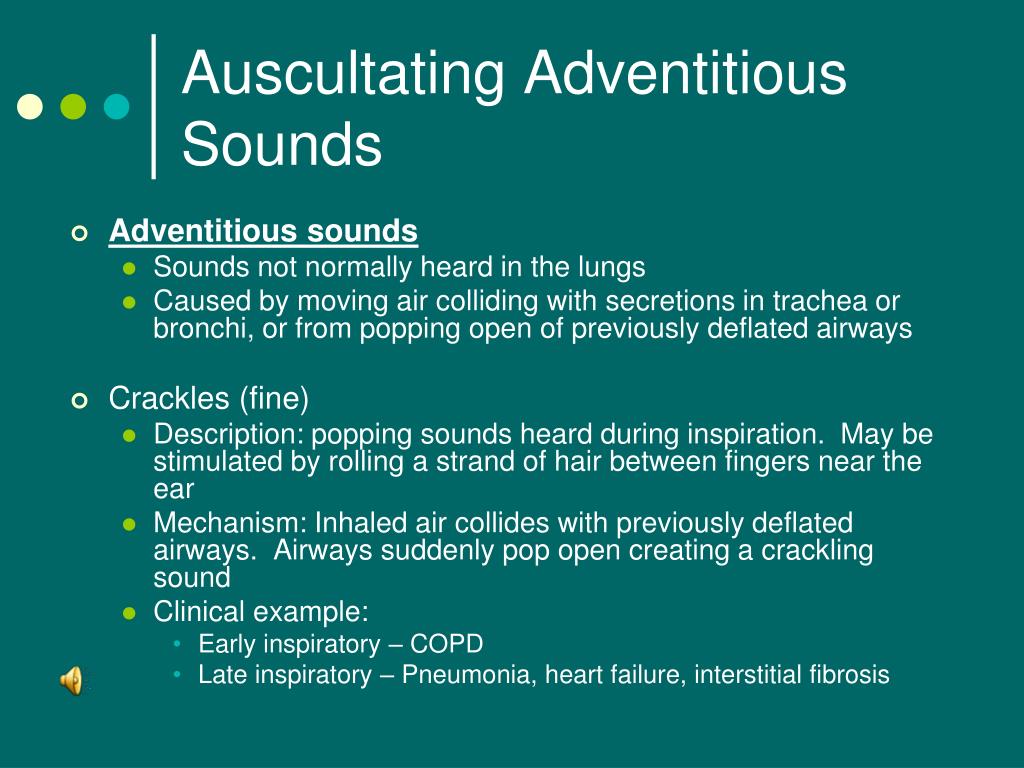

These circumstances that have dramatically impacted all aspects of our lives highlight the importance of early and automated diagnosis of such respiratory disorders more than ever. Viral pneumonia, difficulty in breathing and dyspnea became known as key symptoms in infected patients and in severe cases caused uncountable deaths since the virus outbreak 32. The emergence of the 2019 novel coronavirus (2019-nCoV) has caused a large global outbreak and major public health issues 15.

Wolters Kluwer Health: Philadelphia.Respiratory Sounds Classification | CS 7651 - Machine Learning (Team 7) Respiratory Sounds Classification CS 7651 - Machine Learning (Team 7) View on GitHubĪnjana Nandagopal, Elvan Ugurlu, Fereshteh Shahmiri, Serhat Erdogan, Sukris Vong. Bate’s Guide to Physical Examination and History Taking (13 th ed.). Such conditions include atelectasis, severe COPD, severe asthma, pneumothorax, tension pneumothorax, and extrinsic bronchial compression from tumor.īickley, L. Diminished breath sounds can be caused by anything that prevents air from entering the lungs.Expiratory stridor or mixed inspiratory/expiratory stridor suggests obstruction below the vocal cords (i.e., croup, bacterial tracheitis, tumor, foreign body).Inspiratory stridor suggests obstruction above the vocal cords (i.e., angioedema, epiglottitis, foreign body).Stridor usually requires immediate intervention. It is often intense and can be heard without a stethoscope. Stridor is a high-pitched musical breath sound resulting from turbulent air flow in the larynx or lower in the bronchial tree.Crackles suggest the presence of intra-alveolar fluid as seen with congestive heart failure, pneumonia, and interstitial lung disease. The sound of hair being rubbed between one’s fingers is often used as an example to describe these types of sounds. Crackles or rales may be described as fine (soft, high-pitched) or coarse (louder, low-pitched).Although many clinicians still use the term rhonchi, some prefer to refer to the characteristic musical sounds simply as high-pitched or low-pitched wheezes. Rhonchi, unlike wheezes, may disappear after coughing, which suggests that secretions play a role. It has a snoring, gurgling or rattle-like quality. Rhonchi are a lower pitched variant of the wheeze. Rhonchi are characterized by low pitched sounds heard on inspiration and expiration.Common causes include asthma, emphysema, anaphylaxis, a foreign body in the mainstem bronchus, or a fixed lesion such as a tumor. A wheeze is the result of narrowed airways. Wheezing is a continuous high-pitched musical sound on expiration or inspiration.When possible, seek out learning experiences to hear different breath sounds!

COPD ADVENTITIOUS BREATH SOUNDS HOW TO
Become familiar with the sounds and how to correctly document them. Here’s a list of common adventitious breath sounds with explanations and causes. Facing Ethical Challenges with Strength and CompassionĪbnormal sounds are also called adventitious breath sounds.
COPD ADVENTITIOUS BREATH SOUNDS PROFESSIONAL


 0 kommentar(er)
0 kommentar(er)
